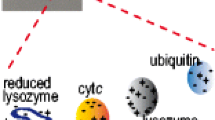Abstract
Field-based ion generation is described for ambient mass spectrometry. The technique allows the analysis of endogenously expressed chemicals and exogenously applied compounds directly from the cuticle of live insects in real time. Cuticular hairs serve as electric field-enhancing structures and play a key role in ion generation. Artificial emitters such as graphite whiskers or sharp metal tips replicate this effect.

Fruit fly in front of the ion trap entrance capillary (see file Online_abstract_figure.jpg).




Similar content being viewed by others
Abbreviations
- AP:
-
Atmospheric pressure
- APCI:
-
Atmospheric pressure chemical ionization
- DART:
-
Direct analysis in real time
- DESI:
-
Desorption electrospray ionization
- ESI:
-
Electrospray ionization
- FBIG:
-
Field-based ion generation
- FD/FI:
-
Field desorption/field ionization
- HC:
-
Hydrocarbon
- HC1:
-
Z-11-Hexadecenyl acetate
- HC2:
-
Z-11-Hexadecen-1-ol
- HC3:
-
Z-11-Hexadecenal
- IR:
-
Infrared
- IT:
-
Ion trap
- MALDI:
-
Matrix-assisted laser desorption/ionization
- MS:
-
Mass spectrometry
- PESI:
-
Probe electrospray ionization
- Q-TOF:
-
Quadrupole time-of-flight
References
Takats Z, Wiseman JM, Gologan B, Cooks RG (2004) Science 306:471–473
Chipuk JE, Brodbelt JS (2008) J Amer Soc Mass Spectrom 19:1612–1620
Cody RB, Laramee JA, Durst HD (2005) Anal Chem 77:2297–2302
Yu S, Crawford E, Tice J, Musselman B, Wu J-T (2009) Anal Chem 81:193–202
Chen H, Wortmann A, Zenobi R (2007) J Mass Spectrom 42:1123–1135
Chen H, Yang S, Wortmann A, Zenobi R (2007) Angew Chemie 46:7591–7594
Yew JY, Cody RB, Kravitz EA (2008) Proc Natl Acad Sci 105:7135–7140
König S, Kollas O, Dreisewerd K (2007) Anal Chem 79:5484–5488
Pirkl A, Dreisewerd K, Yew JY, König S (2009) 18th IMSC, Bremen, PWA326
König S, Dreisewerd K, Yew JY, Pirkl A (2009) MassSpecEurope, Barcelona
König S, Pirkl A, Dreisewerd K, EU patent application EP08157207, 29.05.2008, EP08019430.1, 6.11.2008, 28.5.2009; proposal to IZKF Münster 19.12.2007
König S, Haegele KD, Fales HM (1998) Anal Chem 70:4453–4455
Linden HB (2004) Eur Mass Spectrom 10:459–468
Hiraoka K, Nishidate K, Mori K, Asakawa D, Suzuki S (2007) Rapid Commun Mass Spectrom 21:3139–3144
Chen LC, Nishidate K, Saito Y, Mori K, Asakawa D, Takeda S, Kubota T, Terada N, Hashimoto Y, Hori H, Hiraoka K (2008) Rapid Commun Mass Spectrom 22:2366–2374
Hiraoka K, Chen LC, Yu Z, Takeda S, Kubota T (2009) 18th IMSC, Bremen, PWA289
Jeng J, Lin C-H, Shiea J (2005) Anal Chem 77:8170–8173
Beckey HD (1959) Z Naturforsch 14A:712–721
Gross JH (2004) Mass Spectrometry. Springer, Heidelberg, pp 355–380
Schulten H-R, Beckey HD (1974) Org Mass Spectrom 9:1154–1155
Schaub TM, Hendrickson CL, Qian K, Quinn JP, Marshall AG (2003) Anal Chem 75:2172–2176
Anikin NB, Starikovskaia SM, Starikovskii AY (2006) J Physics D Appl Physics 39(15):3244–3252
Pillai UR, Sahle-Demessie E (2005) Chem Commun 17:2256–2258
Yew JY, Dreisewerd K, Luftmann H, Müthing J, Pohlentz G, Kravitz EA (2009) Current Biology 19(15):1245–1254
Acknowledgments
K.D. acknowledges a grant from the German Research Foundation (DFG DR416/5-1). J.Y. was supported by a Human Frontier Science Program short-term fellowship and partly by grants to Prof. E.A. Kravitz from the National Institute of General Medical Sciences (GM074675 and GM067645) and National Science Foundation (IDS-075165). Scanning electron microscopy experiments were performed in the group of Prof. Dr. R. Reichelt (Institut für Medizinische Physik und Biophysik, Westfälische Wilhelms-Universität Münster) by Mrs. U. Keller and are highly appreciated. The authors also thank K. Rix for technical assistance.
Author information
Authors and Affiliations
Corresponding author
Electronic supplementary material
Below is the link to the electronic supplementary material.
ESM 1
(PDF 753 kb)
Rights and permissions
About this article
Cite this article
Pirkl, A., Dreisewerd, K., Yew, J.Y. et al. Field-based ion generation from microscale emitters on natural and artificial objects for atmospheric pressure mass spectrometry. Anal Bioanal Chem 397, 3311–3316 (2010). https://doi.org/10.1007/s00216-009-3184-z
Received:
Revised:
Accepted:
Published:
Issue Date:
DOI: https://doi.org/10.1007/s00216-009-3184-z




